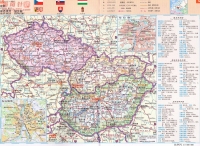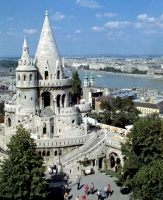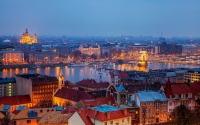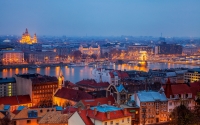歐洲:
英国 United Kingdom 爱尔兰 Ireland 比利时 Belgium 荷兰 Netherlands 法国 France 西班牙 Spain 葡萄牙 Portugal 意大利 Italy 希腊 Greece 奥地利 Austria 匈牙利 Hungary 德国 Germany 瑞士 Switzerland 罗马尼亚 Romania 俄罗斯 Russia 波兰 Poland 克罗地亚 Croatia (Hrvatska) 捷克 Czech 芬兰 Finland 瑞典 Sweden 挪威 Norway 冰岛 Iceland 土耳其 Turkey 丹麦 Denmark 阿尔巴尼亚 Albania 爱沙尼亚 Republic of Estonia 安道尔 Andorra 白俄罗斯 Belarus 保加利亚 The Republic of Bulgaria 波斯尼亚和黑塞哥维那 Bosnia and Herzegovina 梵蒂冈 Vatican City State (Holy See) 黑山 The Republic of Montenegro 拉脱维亚 Latvia 立陶宛 Republic of Lithuania 列支敦士登 Liechtenstein 卢森堡 Luxembourg 马耳他 Republic of Malta 马其顿 The Republic of Macedonia 摩尔多瓦 The Republic of Moldova 摩纳哥 Monaco 塞尔维亚 the Republic of Serbia 斯洛伐克 The Slovak Republic 斯洛文尼亚 the Republic of Slovenia 圣马力诺 San Marino 乌克兰 Ukraine | ||||
匈牙利 Hungary
首都:布達佩斯 國家代碼: hu
| ||||
|
國名 匈牙利共和國(the Republic of Hungary)。
國名釋義 以民族名稱命名。一般認為匈牙利的主要民族馬紮爾族即匈牙利族。“匈牙利”的含意是“十個部落”。 國旗 呈長方形,長與寬之比為3∶2。自上而下由紅、白、緑三個平行相等的橫長方形相連而成。紅色象徵愛國者的熱血,還象徵國傢的獨立和主權;白色象徵和平,代表人民追求自由和光明的美好願望;緑色象徵着匈牙利的繁榮昌盛,象徵人民對未來充滿信心和希望。 國徽 為盾徽。盾面垂直分為兩部分:左邊為平行、紅白相間的寬條;右邊下方是緑色的山峰,峰頂上有一頂王冠,王冠上面是白色雙十字圖案,這是主教標志。盾徽上面是一個聖斯提芬大王冠,王冠之上有一傾斜的十字架,傳說十字架是王冠被竊時讓小偷壓斜的。 國歌 《匈牙利共和國國歌》。 獨立日 11月16日(1918年) 國慶日 8月20日(1949年) 大屠殺紀念日:4月16日(1944年) 爭取自由鬥爭日:3月15日(1848年) 民族 馬紮爾族占總人口的98%,其他有日耳曼族、斯洛伐剋族、羅馬尼亞族、塞爾維亞族等。有一說法是中國古代的匈奴。 (有詩證明:我們那遙遠的祖先,你們是怎麽從亞洲走過漫長的道路,來到多瑙河邊建立起國傢的?---------匈牙利詩人 裴多菲) 首都 布達佩斯(Budapest)。人口170萬(2006年1月1日)。 主要城市 米什科爾茨、德布勒森、塞格德。 貨幣 福林。 同北京時差 -7.00 國際電話碼 36 國花 鬱金香——(百合科) 名勝 巴拉頓湖、巴拉德拉洞群、聖·伊斯特萬大教堂。 風俗 婦女婚後,便用花布把頭髮包住,這是與未婚少女的最大區別。結婚需經求婚、訂婚和迎娶三個階段,訂婚的儀式必不可少,雙方都由一位女性親戚陪同去神父處登記。 國傢政要: 總統紹約姆·拉斯洛 (Solyom Laszlo) ,2005年6月當選;總理久爾恰尼·費倫茨(Gyurcsany Ferenc) ,2004年9月當選,2006年4月,社會黨在國會大選中獲勝,贏得組閣權,同年6月,久爾恰尼宣誓就任總理。 人口 1006萬(2007年1月1日)。主要民族為馬紮爾族(即匈牙利族),約占98%。少數民族有斯洛伐剋、羅馬尼亞、剋羅地亞、塞爾維亞、斯洛文尼亞、德意志和吉卜賽等族。官方語言為匈牙利語。居民主要信奉天主教(66.2%)和基督教(17.9%)。15歲以上公民有98.9%的人具有基本教育水平。 自然地理 面積為93030平方公裏。是位於歐洲中部的內陸國傢,全境以平原為主,80%的國土海拔不足200米,屬多瑙河中遊平原。多瑙河以東的匈牙利大平原,面積約5萬平方公裏,還有西北部的小平原,大部海拔100-150米。山地不足五分之一,北部為喀爾巴阡山脈的一部分,海拔300-1,000米。北部山地的凱凱什峰為全國最高點,海拔1015米。西部外多瑙山地為阿爾卑斯山的餘脈,一般海拔300-500米,最高科裏什峰,海拔704米。包科尼山南麓的巴拉頓湖,為中歐最大湖泊。 山區森林茂密,有櫟樹、山毛櫸、椴樹等;平原有大片草原,發育有肥沃的黑土。重要河流為多瑙河及其支流蒂薩河。巴拉頓湖為最大淡水湖。屬溫帶大陸性氣候,平均氣溫1月-4~-2℃,7月20~22℃,年降水量480~800毫米,自西嚮東遞減。東鄰羅馬尼亞,南接塞爾維亞,西與奧地利接壤,北與捷剋、斯洛伐剋、烏剋蘭為鄰。鋁土礦儲量豐富,分佈在外多瑙山地一帶;還有煤、石油、天然氣、鐵、錳、鈾等礦藏。全境三分之二地區有地下熱水藴藏。 簡史 匈牙利國傢的形成起源於東方遊牧民族──馬紮爾遊牧部落,公元9世紀時他們從烏拉爾山西麓和伏爾加河灣一帶嚮西遷徙,公元896年在多瑙河盆地定居下來。公元1000年,聖·伊斯特萬國王加冕,正式建立封建國傢。15世紀下半葉馬嘉什國王統治時期是匈牙利歷史上較為輝煌的時期。1526年土耳其入侵,封建國傢解體。1699年開始全境由哈布斯堡王朝統治。1848年爆發了科蘇特領導的自由革命鬥爭。1849年4月匈國會通過獨立宣言,建立匈牙利共和國,但不久被奧地利和沙俄軍隊所扼殺。1867年奧匈協定宣佈成立奧匈帝國。第一次世界大戰後奧匈帝國解體。1918年11月匈宣佈成立第二個資産階級共和國。1919年3月21日匈牙利蘇维埃共和國成立,同年8月被帝國主義干涉者聯合武裝進攻所顛覆,恢復了君主立憲政體,開始了霍爾蒂的法西斯統治。1945年4月蘇聯紅軍在匈牙利人民配合下解放了匈全境,1946年2月宣佈廢除帝製成立匈牙利共和國,1949年8月20日成立匈牙利人民共和國並頒布憲法。1956年10月爆發匈牙利事件。1989年10月23日,根據憲法修正案,决定將匈牙利人民共和國改稱匈牙利共和國。1999年底通過王冠法,並成立以總統為首的王冠委員會。 政治 1989年匈牙利政局發生急劇變化,同年2月,匈牙利社會主義工人黨(簡稱社工黨)宣佈放棄執政黨地位,實行多黨製。此後,匈黨內矛盾不斷公開化,最後導致黨的分裂。1989年10月,社工黨改名為社會黨,提出要在匈牙利建立“民主社會主義”。當月,匈國會通過憲法修正案,把“匈牙利人民共和國”改為“匈牙利共和國”,决定取消作為集體國傢元首的共和國主席團,實行總統製;確立多黨製和議會民主的法治國傢;取消馬列主義政黨在國傢機構中的領導作用的規定。 經濟 匈牙利是一個具有中等發展水平的國傢,工業基礎較好。匈根據本國國情,研發和生産一些有自己特長的和知識密集型産品,如計算機、通訊器材、儀器、化工和醫藥等。匈采取各種措施優化投資環境,是中東歐地區人均吸引外資最多的國傢之一。 自然資源比較貧乏,主要礦産資源是鋁礬土,其藴藏量居歐洲第三位。此外有少量褐煤、石油、天然氣、鈾、鐵、錳等。森林覆蓋率約為18%。農業基礎較好,在國民經濟中占重要地位,不僅為國內市場提供豐富的食品,而且為國傢掙取大量外匯。主要農産品有小麥、玉米、甜菜、馬鈴薯等。旅遊業比較發達。 匈牙利雖然資源貧乏,但山河秀美,建築壯麗和富有特色,這裏溫泉遍布,氣候四季分明,各國遊客慕名而來。主要旅遊點有布達佩斯、巴拉頓湖、多瑙河灣、馬特勞山。坐落在多瑙河畔的首都布達佩斯是歐洲著名的古城,風光無限,有“多瑙河上的明珠”之美譽。歐洲最大的淡水湖巴拉頓湖也是吸引大批遊客的一個亮點。另外,匈牙利的葡萄美酒也為這個國傢增光添彩,以其歷史悠久、酒味醇香聞名於世。匈牙利獨特的自然風光和人文景觀使其成為旅遊大國,成為匈外匯重要來源之一。 1989年以來,匈牙利經歷了從計劃經濟嚮市場經濟的轉變,其目標是盡快地與歐洲經濟溶為一體。隨着政治局勢的穩定和經濟的不斷發展,匈牙利於1996年加入了經濟合作發展組織,1999年加入北大西洋公約組織,2002年歐盟宣佈將於2004年接納匈牙利、波蘭、捷剋等申請加入的國傢為其正式成員。匈現正按照歐盟的法律框架加緊完善其國內法律體係。 九十年代中期,匈大刀闊斧地推行了一套經濟改革計劃,即在市場經濟的基礎上實施私有化和經濟自由化的政策,大力吸引外國投資。改革取得了明顯的成效,匈失業率逐年下降,通貨膨脹大幅度降低,外國投資不斷涌入,匈很快地走上了以出口帶動經濟快速增長的道路,近2000傢國營企業在私有化過程中被出售,私營經濟占國內生産總值的比例由1989年的20%增至2000年的80%以上。 1997—2000年,匈經濟平均增長率超過了4%。2001年,儘管其國內生産總值的增幅放慢,但仍然是中東歐地區增長率最高的國傢之一,且高於歐盟的平均增長水平。 在過去較長一段時期,匈牙利通貨膨脹率一直高居不下,嚴重製約着經濟增長。為此,匈中央銀行采取了嚴格的貨幣政策,確保物價的穩定,控製通貨膨脹的攀升。2001年,匈中央銀行放棄了執行多年的匯率小幅貶值機製,將其上下波動幅度各增加15%,並將原來實行的福林與美元挂鈎改為與歐元挂鈎。通過各方面的努力,2002年匈通貨膨脹率由上年的6.8%降到了5.3%,經濟增長率為3.3%,經濟增長主要得益於旅遊和建築業的持續增長以及政府采取的增加工資、擴大消費需求的財政刺激政策。2002年,經常賬戶赤字計劃保持在國內生産總值的4.5%以下。匈貨幣福林目前已實現了自由兌換。 2002年穆迪投資服務公司將匈牙利政府外幣債券的信用評級由BBB3提高到A1。匈在中東歐地區競爭力的排名僅次於斯洛文尼亞居第二位。 【工業】 匈牙利工業政策是以促進投資為宗旨,以支持企業的研發和創新以及建立起一個廣泛的産品供銷網絡為目標,提高工業競爭力以便為加入歐盟做好準備。匈工業主要行業有機械製造、醫藥、信息技術和食品加工等。 匈2000年工業生産增長率為18.3%,而2001年降至4.1%,2002年更降至2.6%.匈工業生産增長主要來自於信息技術、電訊和傢電等部門的發展。 【基礎設施】 匈牙利的交通基礎設施在政府的支持下進行了大規模重建,高速公路公裏數不斷增加。鐵路仍屬國營,由於其運輸成本低且安全可靠而被廣泛地運用於工業運輸。匈牙利國際機場位於布達佩斯市郊,該機場擁有兩個現代化的航空集散站。 匈牙利電信係統較為完善,其移動通訊業尤為發達。為了符合加入歐盟的要求,匈牙利政府2001年通過了一個電信自由化法案。該法案開放了國內和國際固定電話市場,移動通訊市場亦已放開。目前,匈牙利國傢電話公司在國際長途和國內固話市場上仍占主導地位。匈牙利目前約有50傢互聯網服務供應商。 【勞動力】 匈牙利勞動力素質較高,其勞動力人口約為410萬,大都受過高等教育且具有特定的技能和專長。匈牙利受教育人口比例超過了人口總數的98%,大約三分之二的勞動力已經完成了一種專長或多種形式的技術培訓和職業教育,匈牙利許多年輕人掌握英語、德語和法語等外語。 2001年匈牙利失業率為5.4%,大大低於歐盟的平均水平。匈牙利各地區就業狀況存在較大差別,西北地區技術工人短缺,特別是金融和市場營銷人才,而多瑙河的東部失業率則高於全國的平均水平。 匈牙利的工資水平大大低於西歐地區,與中東歐的平均水平相差無幾。匈東部地區的勞動力成本比西部低,但勞動者的技術水平與西部不相上下。 【匈牙利的外國投資】 外國投資是匈牙利外貿出口和經濟增長的重要動力。通過私有化進程,匈吸引了大批的外國投資。 在私有化方式上,匈牙利並未采用大部分東歐國傢所實行的票券私有化方式,因為票券私有化大大地限製了外國投資者收購匈整個公司的可能性。匈牙利鼓勵外國投資者整體收購國有企業。 自1990年以來,匈共有1500多傢國有企業實現了私有化,私有化收入超過100億美元。自1995年6月《私有化法案》及其修正案頒布以來,私有化進程明顯加快,其程序也更加透明。匈牙利私有化和國有控股公司是負責管理和出售國有企業資産的專門機構。 自1990年以來,外國投資者在匈投資創辦了約30000傢企業,投資額約為284億美元,約占中東歐地區吸引外資的三分之一,匈牙利因而成為中東歐地區吸收外資最多的國傢之一。匈人均吸引外資2480美元,位居中東歐地區首位。 在匈牙利投資較多的國傢還包括法國、意大利、日本和英國等國。投資額在1000萬美元以上的項目中,美國占29%,德國占26%,法國占11%,荷蘭占10%。 外資産值約占國內生産總值的三分之一,雇用了全國43%的勞動力,其出口額占全部出口的70%。 外資企業對提高匈牙利的勞動生産率起到了重要的作用。這些企業大多重視産品質量和技術創新,並開始建立起新的産業,如汽車組裝、零部件生産、電子工業元件等。外資企業對於匈牙利電信、醫藥和食品工業的現代化更是起到了關鍵作用。 外國投資的産業結構正發生變化:製造業的比例從2001年的50%下降至2002年的36%,而在房地産、租賃、輔助商業活動(16%)、金融服務業(12%)、電力和天然氣、供暖和供水(9%)等領域投資比例都有顯著的提高. 目前世界上最大的50傢跨國公司中已有45傢進駐匈牙利,其中包括:通用電器、通用汽車、奧迪、IBM,Elextronics、菲力普、諾基亞、Ameritech-Deutsche Telekom,Electrolux、西門子公司等。一些跨國公司將其在匈實現的利潤又進行了再投資。 越來越多的外資企業將註意力集中在高附加值、高品質的産品中。很多公司如通用電器、通用汽車、歐寶、諾基亞、奧迪、西門子、 Flextronics、菲力普、愛立信等企業已經遷往匈牙利。通用電器照明公司决定於2002年2月將位於倫敦的負責歐洲、中東和非洲地區事務的區域性中心遷至匈牙利。 由於匈牙利的地理位置優越,越來越多的外資企業傾嚮於在匈牙利建立輔助性服務中心,通用電器公司、Dlageo Pic和電子數據係統公司在過去的兩年中已經在匈牙利建立了輔助中心。 在過去的幾年中,匈政府重點鼓勵發展以下行業:住房、橋梁和高速公路建設、中小企業的發展、旅遊、創新和研發(特別是在信息科技領域)。 【匈牙利的外貿】 匈牙利是世界貿易組織(WTO)的成員,並將在2004年成為歐盟的一員。它同時還是歐洲自由貿易協定(EFTA)、中歐自由貿易地區(CEFTA)的成員。另外,匈還與以色列、土耳其、剋羅地亞和愛沙尼亞簽定了雙邊自由貿易協定。為符合世界貿易組織的規定,自2001年1月1日起,匈牙利取消了來自於世界貿易組織成員國的産品配額。從歐盟和中歐自由貿易額地區國傢進口的工業産品的關稅也同時取消。 匈牙利對外貿易分類 匈牙利的出口增長主要依賴於在匈投資的跨國公司,其出口額中的70%來自於這些企業。 90年代中期,隨着外國投資的大量涌入,匈牙利出口增幅較快,1997年和1998兩年的增長率均達到20%,2002年貿易增長率為12.6%,外貿總額達343億美元,其中進口增長了11.7%,達376億美元。 與過去相比,匈牙利主要貿易夥伴已發生了很大變化:對歐盟的外貿額占其外貿總額的三分之二,而在1989年前,與前經互會國傢的貿易占其外貿的三分之二。2002年匈牙利82%的産品出口到發達國傢,其中75.1%銷往歐盟國傢,而14%銷往歐盟國傢,而14%銷往中歐自由貿易協定國傢。在進口方面,匈牙利從發達國傢的進口占進口總額的66.8 %,其中56.3%來自於歐盟,16-17%來自於其它地區。 2002年,匈牙利主要貿易夥伴:德國、奧地利、意大利、法國、美國,對匈出口較多的國傢分別為德國、意大利、奧地利、俄羅斯、中國、法國、日本和美國。 匈牙利外貿的産業結構發生了很大變化:出口産品中機械産品所占的比例由1991年21%增至2002年的58%:製成品居於第二位,占30.8%。燃料和電力維持在原水平(2-3%)。農産品、食品以及原材料在出口中所占的比例在過去幾年持續下降,約占9%。2002年,農産品和食品所占比例接近7%,在進口方面,機械設備的進口占比最高,為52%,其次是製成品,占35.5%。 匈牙利進口的主要産品有:石油、天然氣、汽車零部件、計算機設備、汽輪機、測量儀器;出口的産品有:電子産品、機械設備、交通工具(非鐵路)以及化工産品等。 新聞出版 目前在匈辦報無須批準,到文教部登記即可。不少刊物有外國股份。2001年發行量較大的全國性報紙有7種,其它刊物87種。主要日報有《地鐵報》、《今日一瞥》、《人民自由報》、《民族體育報》、《匈牙利民族報》、《快報》、《匈牙利新聞報》、《人民之聲報》。匈牙利通訊社為國營,1880年成立。主要廣播電臺有科舒特廣播電臺(1949年成立)和裴多菲廣播電臺,均為國營電臺。此外還有鮑爾多剋廣播電臺和道努比烏斯廣播電臺。主要電視臺有匈牙利電視臺,國營,1958年成立。多瑙河電視臺,私營。 外交 奉行獨立的、以民族利益為基礎的對外政策。在維護東西方平衡的外交關係的同時,爭取返回歐洲,早日加入歐盟。1999年3月,匈牙利正式加入北約。2004年5月1日,匈牙利正式成為歐盟成員國。 與中國關係 1949年10月6日,匈牙利與中國建立大使級外交關係。 Names In the late middle age, the Latin terms "Natio Hungarica" and "Hungarus" referred to all noblemen of the Kingdom. A Hungarus-consciousness (loyalty and patriotism above ethnic origins) existed among all inhabitants of this state. However, according to István Werbőczy's Tripartitum, the "Natio Hungarica" were only the privileged noblemen, subjects of the Holy Crown of Hungary regardless of ethnicity. The Latin name Regnum Hungariae/Vngarie (Regnum meaning kingdom); Regnum Marianum (The Kingdom or Reign of St. Mary); or simply Hungaria was the form used in official documents from the beginning of the kingdom to the 1840s, the German name (Königreich Ungarn) from 1849 to the 1860s and the Hungarian name (Magyar Királyság) in the 1840s and from the 1860's to 1918. The names in other languages of the kingdom were: (Hungarian: Magyar Királyság, Polish: Królestwo Węgier, Romanian: Regatul Ungariei, Serbo-Croatian: Краљевина Угарска/Kraljevina Ugarska, Slovene: Kraljevina Ogrska, Czech: Uherské království, Slovak: Uhorské kráľovstvo. History of the Kingdom of Hungary Medieval Hungary controlled more territory than medieval France (with only the Holy Roman Empire being larger than Hungary), and the population was the third largest of any country in Europe. The Kingdom of Hungary arose in present-day western Hungary and present-day western Slovakia, and subsequently spread to remaining present-day Hungary, to Transylvania (in present-day Romania), present-day eastern Slovakia, Carpatho-Ruthenia, Vojvodina (in present-day Serbia) and other smaller nearby territories. It existed in personal union with the Kingdom of Croatia from 1102 until 1918 under the name Lands of the Crown of St. Stephen. The Hungarian Holy Crown of Saint Stephen.The first kings of the Kingdom were from the Árpád dynasty. In the early 14th century, this dynasty was replaced by the Angevins, and later the Jagiellonians as well as several non-dynastic rulers, notably Sigismund, Holy Roman Emperor and Matthias Corvinus. At the Battle of Mohács in 1526, the Hungarian army was defeated by the forces of the Ottoman Empire, and Louis II of Hungary ran away and drowned in the Csele Creek. Under the Ottoman attacks the central authority collapsed and a struggle for power broke out. The majority of Hungary's ruling elite elected John Zápolya (10 November 1526). A small minority of aristocrats sided with Ferdinand I, Holy Roman Emperor who was Archduke of Austria and was related to Louis's family by marriage, as King of Hungary; there had been previous agreements that the Habsburgs would take the Hungarian throne if Louis died without heirs, as he did. Ferdinand was elected king by a rump diet in December 1526. On 29 February 1528, King John I of Hungary received the support of the Ottoman Sultan. A three-sided conflict ensued as Ferdinand moved to assert his rule over as much of the Hungarian kingdom as he could. By 1529 the kingdom had been split into two parts: Habsburg Hungary and "eastern-Kingdom of Hungary". At this time there were no Ottomans on Hungarian territories, except Srem's important castles. By 1541, the fall of Buda marked a further division of Hungary, in three parts and remained so until the end of the 17th century. Although the borders were changing very frequently during this period, the three parts can be identified more or less as follows: Present-day Slovakia, north-western Transdanubia, Burgenland, western Croatia, and adjacent territories were under Habsburg rule. This area was referred to as Royal Hungary, and though it nominally remained a separate state, it was administered more or less as part of the Habsburgs' Austrian holdings, to which it was immediately adjacent. This was the continuation of the Kingdom of Hungary. Map of the counties in the Lands of the Crown of St. Stephen (the Kingdom of Hungary proper and Croatia-Slavonia) around 1880The Great Alföld (i.e. most of present-day Hungary, incl. south-eastern Transdanubia and the Banat), partly without north-eastern present-day Hungary, became part of the Ottoman Empire (see Ottoman Hungary). The remaining territory became the newly independent principality of Transylvania, under Zápolya's family. Transylvania was a vassal state of the Ottoman Empire. After a failed Ottoman invasion of Austria in 1683, the Habsburgs went on the offensive against the Turks; by the end of the 17th century, they had managed to conquer the remainder of the historical Kingdom of Hungary and the principality of Transylvania. At this point, the Royal Hungary terminology was dropped, and the area was once again referred to as the Kingdom of Hungary, although it was still administered as a part of the Habsburg realm. In the 18th century, the Kingdom of Hungary had its own Diet (parliament) and constitution, but the members of the Governor's Council (Helytartótanács, the office of the palatine) were appointed by the Habsburg monarch, and the superior economic institution, the Hungarian Chamber, was directly subordinated to the Court Chamber in Vienna. The official language of the Kingdom of Hungary remained Latin until 1844; it was Hungarian between 1844 and 1849 then from 1867. Austria-Hungary The coat of arms of the Kingdom of HungaryFollowing the Austro-Hungarian Compromise of 1867, the Habsburg Empire became the "dual monarchy" of Austria-Hungary. The Austro-Hungarian economy changed dramatically during the existence of the Dual Monarchy. Technological change accelerated industrialization and urbanization. The capitalist way of production spread throughout the Empire during its fifty-year existence. The obsolete medieval institutions continued to disappear. By the early 20th century most of the Empire had started to experience rapid economic growth. The GNP per capita grew roughly 1.45% per year from 1870 to 1913. That level of growth compared very favorably to that of other European nations such as Britain (1.00%), France (1.06%), and Germany (1.51%). The historic lands of the Hungarian Crown (the Kingdom of Hungary proper, to which Transylvania was soon incorporated, and Croatia-Slavonia, which maintained a distinct identity and a certain internal autonomy) was granted equal status with the rest of the Habsburg monarchy; the two states comprising Austria-Hungary each had considerable independence, with certain institutions and matters (notably the reigning house, defence, foreign affairs, and finances for common expenditures) remaining joint. This arrangement was to last until 1918, when 72% of the territory of the Kingdom of Hungary was divided between neighbouring states of Austria/Romania and newly formed states of Czechoslovakia/Kingdom of Serbs, Croats and Slovenes as the Central Powers went down in defeat in World War I. The new borders were set in 1920 by the Treaty of Trianon leaving more than 3,5 million ethnic Hungarians outside the new borders that were originally meant to accord ethnic borders. Kingdom of Hungary between 1920-1944 After the pullout of occupation forces of Romania in 1920 from its war against the Communist regime of Béla Kun, the country went into civil conflict, with Hungarian anti-communists and monarchists purging the nation of communists, leftists and others they felt threatened by. Later in 1920, a coalition of right-wing political forces united and returned Hungary to being a constitutional monarchy. Selection of the new King was delayed due to civil infighting, and a regent was appointed to represent the monarchy. Former Austro-Hungarian navy admiral Miklós Horthy became that regent. The Kingdom of Hungary existing from 1920 to 1944 was a de facto regency state under Regent Miklós Horthy officially representing the abdicated Hungarian monarchy. Attempts by Charles IV King of Hungary to return to the throne were prevented by threats of war from neighbouring countries, and by lack of support from Horthy (see Charles IV of Hungary's conflict with Miklós Horthy). The first ten years of the reinstated kingdom saw increased repression of Hungarian minorities. Limits on the number of Jews permitted to go to university were placed, corporal punishment was legalized. Under the leadership of Prime Minister István Bethlen, democracy dissipated as Bethlen manipulated elections in rural areas which allowed his political party, the Party of Unity to win repeated elections. Bethlen pushed for the revision of the Treaty of Trianon. After the collapse of the Hungarian economy from 1929 to 1931, national turmoil pushed Bethlen to resign. This state was conceived of as a "kingdom without a king," since there was no consensus on either who should take the throne of Hungary, or what form of government should replace the monarchy. The Kingdom of Hungary was one of the Axis powers during World War II until its defection in 1944, in which the state was occupied and dissolved by Nazi Germany and replaced by a briefly-existing puppet state. Historical perceptions In today's Hungary, the Kingdom of Hungary is regarded as one long stage in the development of the same state. This sense of continuity is reflected in the republic's national symbols, holidays, official language and the capital city of the country. The short form of the name is the same in Hungarian (Magyarország). The millennium of the Hungarian statehood was commemorated in 2000 and codified by the Millennium Act of 2000. In contrast, scholars outside Hungary observe that the Kingdom of Hungary, being a multiethnic and later multinational state, "bore little resemblance, in territory or population, to today’s Hungary". This observation is reflected also by the fact that the Croatian, Serbian, Slovak and Slovenian languages (groups formerly within Hungary) have different names for the Kingdom of Hungary and modern Hungary. |
|
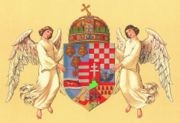
![匈牙利小姐評選揭曉[圖] 5月22日,在匈牙利首都
點擊圖片查看詳情](http://oson.ca/upload/images11/cache/99f9b3f79a958535f05f3c91a76c8b5e.jpg)
